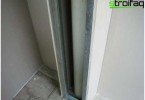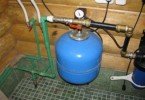How to get a pump out of a well if it is stuck
Submersible pumps used to supply water from wells drilled in the area require periodic lifting for preventive maintenance and minor repairs. Also, the lifting of pumping equipment is associated with the replacement of a unit that has expired, with a more powerful device. However, the operation of removing the submersible pump from the well pipe is not always successful. It also happens that the pump wedges tightly in the pipe. Well owners who first encountered such a problem do not know how to get it well pump so as not to break the cable.
Content
- Causes of pump jamming in the well body
- 1. Sagging electrical cable
- 2. Well siltation as a result of prolonged shutdown
- 3. Solid State Obstacle – Complex Barrier
- 4. The effect of reverse siltation
Causes of pump jamming in the well body
Basically, all the reasons leading to the emergence of this unpleasant problem are due to the human factor. When during the installation of the pump the technological requirements for fastening the elements of the pumping equipment are violated, and due attention is not paid to their workmanship, it is difficult to expect a favorable outcome during the dismantling of the pump.
Sagging electric cable
For this reason, the greatest number of cases of jamming of equipment occurs. This happens by biting a sagging power cable in a loop that is tightened around the pump casing..
In this situation, you should not pull the device with all the force, as this will not lead to success. But what you pull for can break off. Then it will be difficult to do something on their own.

Trying to pull the pump out on your own
Experts who have repeatedly raised pumps from wells, advise in this case to try to shove the device back. Repeating attempts, try to feel weakness and at this moment continue slowly lifting. In general, “it is better to prevent a disease than to cure.” So that in your practice you will not encounter sagging of the electric cable, you must fasten it with special clamps to the pipe or hose at the stage of installation of the system. Moreover, it is not recommended to attach the electric cable to the cable, since when it is tensioned, the clamps can fly off. When lifting the pump, it is also necessary to ensure that the cable and hose exit to the surface at the same time. Slack must not be allowed on the cable or on the cable or on the hose..
Well siltation as a result of prolonged shutdown
There are often cases in practice when a long idle time of a well leads to its strongest siltation. The formed layer of sludge rises an insurmountable barrier in the way of the pump. When the pump is stuck in the well for this reason, experts recommend starting its swinging, during which the device is either raised or lowered. What does this lead to? Water may gradually begin to erode mud deposits. In the end, it is possible that the road up is free, which will allow the pump to be pulled out. The main thing is not to rush things and do not show excessive activity to prevent the pump from jamming.
There is also a non-standard way of dealing with a silty well. It is necessary to bring to the solution of the problem firefighters who, with the help of a sleeve lowered into the well, will be able to erode sludge deposits. A free pump will go upstairs. To prevent siltation of the well, it is necessary to carry out its preventive cleaning, the frequency of which should be once every three years.
Solid State Obstacle – Complex Barrier
A solid obstacle may occur in the path of the pump, which will play the role of a wedge. Such a barrier can be:
- a dent in the pipe caused by soil movement;
- flattened edge of the pipe;
- burrs from sloppy weld;
- rejection in the assembly of the sediment column, in which, instead of the threaded connection of the pipes, they are welded, allowing axial displacement.
Encountering such an obstacle is accompanied by a characteristic hard knock, while the downward movement of the pump is free. Is it possible and how to pull the pump out of the well in this situation? There are cases when the rotation of the pump with the help of a pipe around its axis helps to go around the obstacle that has stood in the way. However, the absolute probability of the release of the movement of the device is not guaranteed. It can be a one-time success. But it’s worth a try, suddenly in a specific situation the problem will be solved in this way.

Specialized assistance
A solid obstacle can also be a tool, a fastener part, or another foreign object that accidentally fell into the well. In this case, the pump stops during the rise sharply and unexpectedly. This happens at the moment of falling into the gap between the wall of the well and the pump of a solid object, which leads to jamming. In this case, the downward movement is free, and upward intervals of jamming vary depending on the selection of the cable. The item will not be able to slip through, the gap is too narrow. Therefore, experts advise to stop, call specialists. The special equipment available to them is able to extract interference from the well.
Reverse siltation effect
This effect is observed in wells made in limestone soils. As a result of long operation, a sedimentary layer is formed above the location of the pump, turning into a “plug”. To stop this process, clean the well every three years..
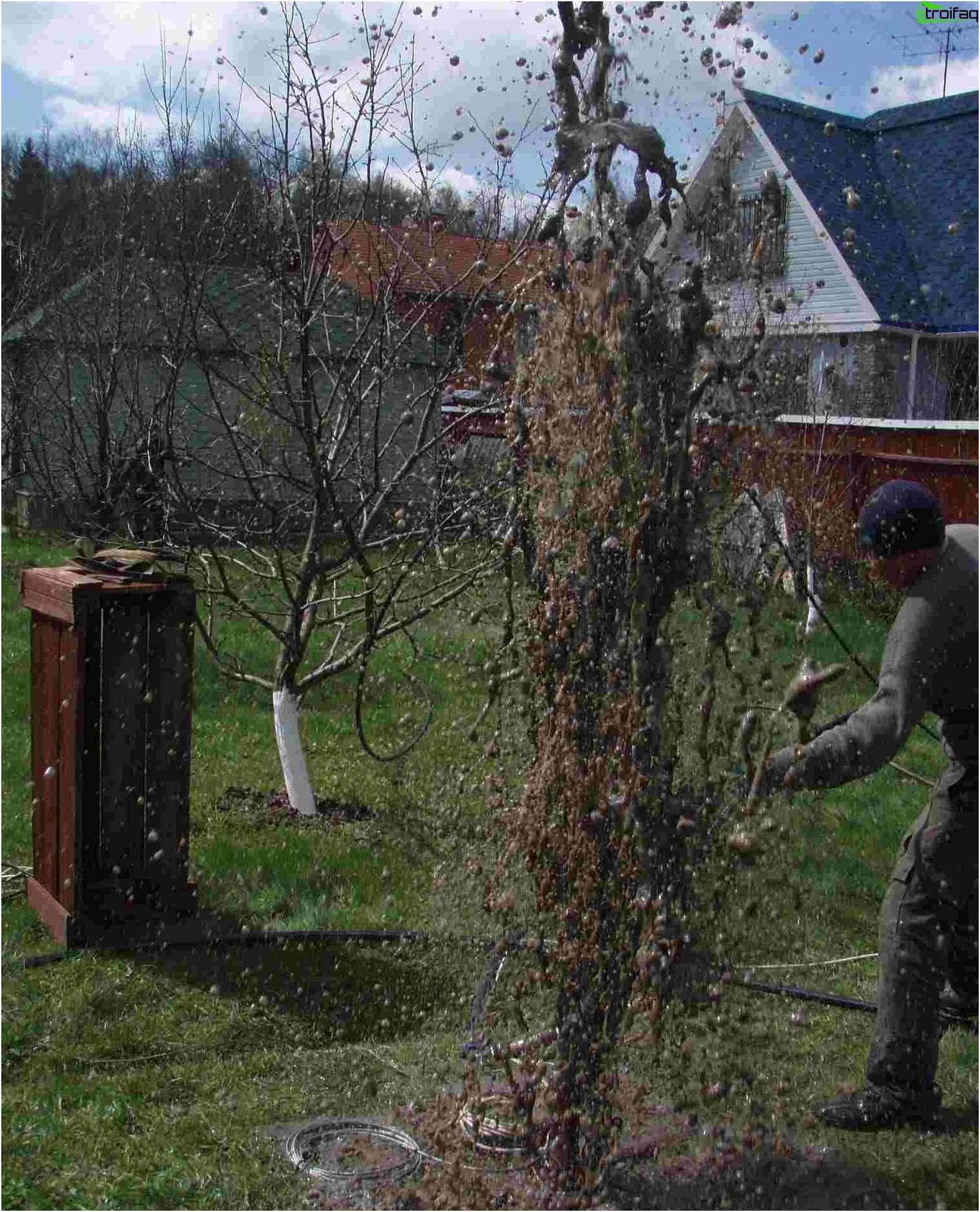
Well cleaning – excellent prevention of siltation and clogging of the wellbore
Craftsmen’s advice
- A stuck pump in a well with a wire cable torn off as a result of an applied effort can be pulled out with a metal device with pins, popularly referred to as a “cat”. Hooking a pump directly is considered a great success. You can most likely grab onto the end of a cable or hose while trying to pull the equipment up..
- To squeeze a stuck pump down, some inventors manage to use scrap tied to a cable. The main thing is to tightly attach the scrap so that when throwing into the well, do not leave it there too. Of course, this can be done if the old pump is no longer supposed to be used, because the probability of damage is very high. May work at shallow depths of the pump.
- Weld the “ear” to the meter section of the pipe. Pass the cable, hose and cable through the pipe, lower the pipe on a separate cable into the well. Under pressure from its weight, the pump can slip down and hang freely on the cable. Then simultaneously pull the pipe and pump from the well. Since the weight of the structure can reach 50 kg, the work must be carried out with an assistant.
- If the suspension of the pump has not yet been torn off when trying to force extraction of equipment from the well, you can fix it in a taut form and periodically tap it. If a slack occurs, the cable is pulled again and tapped again. These actions may take several days. The method is for especially patient, but in some cases it is crowned with success.
What pushes people to invent various ways to solve a problem with a stuck pump? The answer is simple, the high cost of services of firms specializing in this area.
In some cases, their cost reaches the price of installing a new well. Therefore, in order to save the budget, you must do everything possible in advance to prevent the pump from jamming..
Valuable professional advice
1. Do not save on the quality of the cable used to suspend a submersible pump. It is advisable to purchase a cable and mounts for it from stainless steel.
2. Try not to use pieces of hoses and cables spliced together inside the well. Indeed, when lifting, these weaknesses can disperse, the scraps will bend and jam the rising device.
3. It is advisable to buy pumps of minimum diameter in order to increase the gap between the walls of the borehole and the body of the equipment. It is clear that pumps having a small thickness are more expensive than their more voluminous counterparts. However, if we compare the difference in the price of pumping equipment with the cost of a new well, then buying a thinner device becomes not so unprofitable. The replacement of the pump in the well will reduce the likelihood of re-jamming of the device.
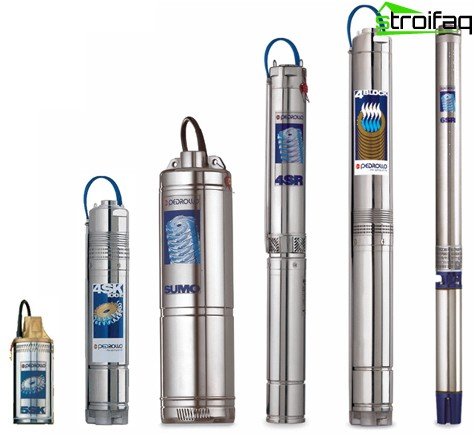
Submersible pumps
4. Install a factory-made tip on the well that fits snugly against the walls of the downhole pipe. This part will prevent debris and various random objects from getting into the well..
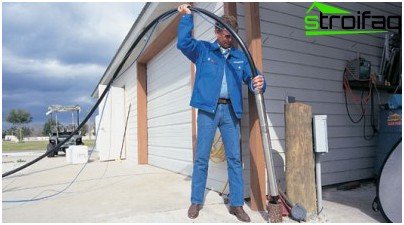
Installation of a new pump in the well
We will be glad if the information presented in the article helps you cope with the problem. It will be even better if you never have to “drag a hippopotamus out of the swamp”, because the installed pump will leave the well like clockwork.
And do not forget to carry out preventive cleaning of the well.



